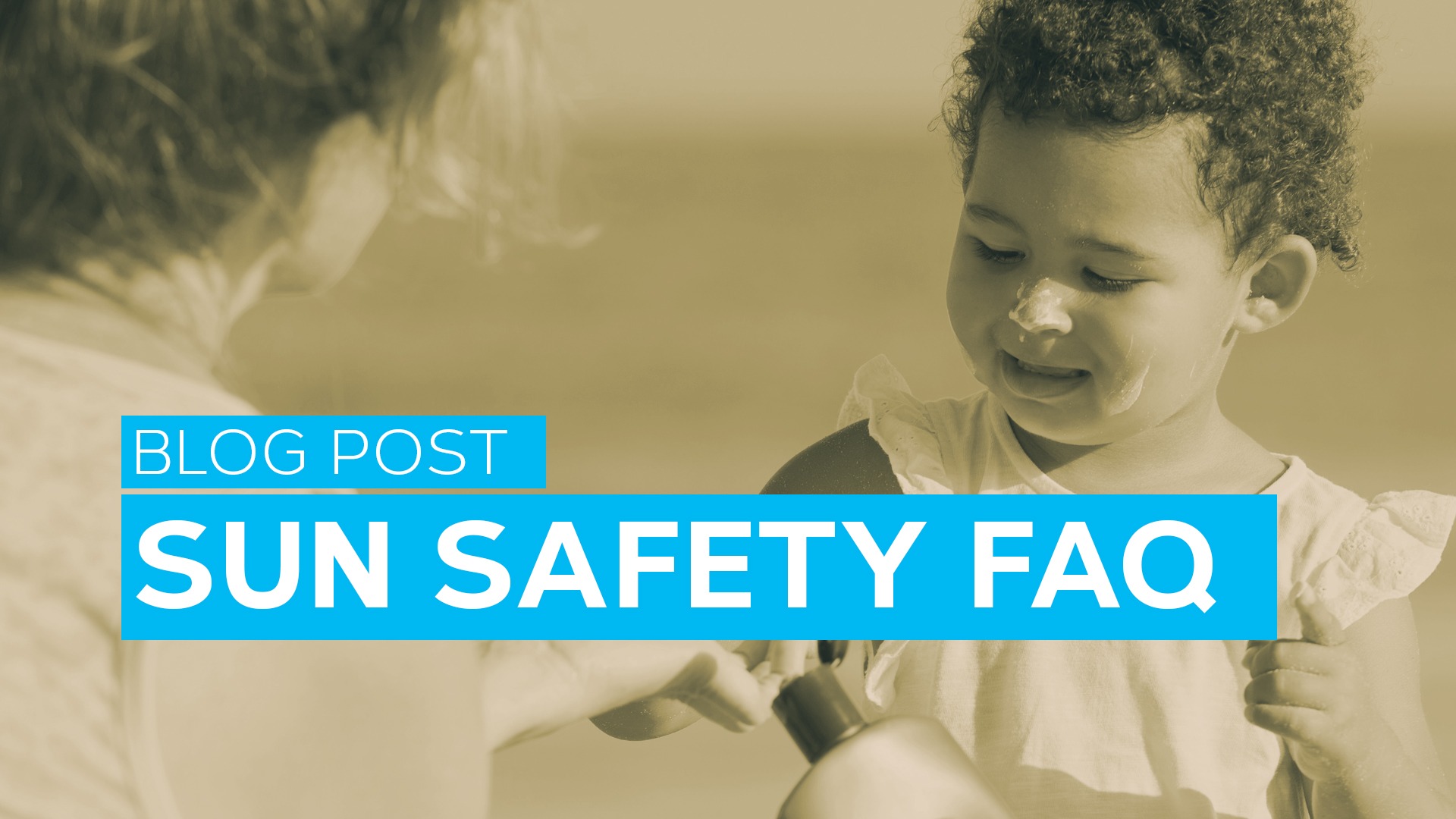Summer is in full swing, which means people are spending a lot more time outdoors and in the sun. Exposure to ultraviolet radiation (UVR) poses many health risks including sunburns, skin cancers, and even damage to the eyes. As the most accessible healthcare professional, pharmacists are in an excellent position to promote and educate patients about the importance of sun safety. This blog answers some of the commonly asked questions from patients to help you brush up on sun safety.
1. Is sunscreen safe to use?
Individuals may be concerned about sunscreen absorption and the effects that absorption may have on the skin and body. Studies have been conducted by the Food and Drug Administration (FDA) on the absorption of various sunscreen active ingredients.2 Although these studies have shown that the ingredients were absorbed into the body, the FDA concluded that additional safety data on these and other active sunscreen ingredients are required in order to better understand their absorption and if there are any long-term effects.2 Both Health Canada and the FDA agree that it is important to advise patients that sunscreen absorption does not necessarily equal risk, the findings do not mean that the ingredients are not safe, and that the use of sunscreen should be continued for significant health benefits, such as sunburn protection, skin cancer prevention, and protection from premature aging.3 Assure patients that Health Canada continues to monitor the situation and if any safety concerns arise, appropriate action will be taken and the public will be notified.3 Alternatively, the ingredients zinc oxide and titanium dioxide, which are found in physical sunscreens are generally recognized as safe and effective and additional safety data on these two ingredients have not been requested by the FDA.2


2. What sun safety precautions can I take for young children?
Infants and toddlers are at an increased susceptibility to UVR penetration and sunscreen absorption.4 As sunscreens are generally not recommended for use on children less than six months of age, sun exposure should be avoided in this age group if possible.4,5 Otherwise they should be kept in the shade as much as possible and dressed in lightweight, loose-fitting, tightly woven clothing that covers the skin (i.e., long sleeves, pants).3,4,5 A wide-brimmed sun hat and sunglasses should also be worn to protect their head and eyes.5 It is also important to ensure that they are kept hydrated and do not overheat.5 If the baby’s skin appears red or if they are fussy or crying excessively, they should be taken indoors.5
For children older than six months of age, a water-resistant broad-spectrum sunscreen with a Sun Protection Factor (SPF) of at least 30 should be applied to all exposed areas of the body, with caution around the eyes.5 Since children under the age of two tend to have more sensitive skin, sunscreens that are meant for young children or sunscreens containing zinc oxide or titanium dioxide are generally preferred as these are less likely to irritate the skin.5,6 Keep in mind that other ingredients found in sunscreens such as fragrances or preservatives can also cause reactions.6
3. If I have sensitive skin does that mean I cannot wear sunscreen because it will irritate my skin?
Sunscreens are made up of ingredients that act as chemical or physical ultraviolet (UV) filters.3 Some sunscreens contain one or the other while others may have both.3 Individuals with sensitive skin are recommended to use physical sunscreens, which work by deflecting UV rays and are therefore less likely to cause a reaction as compared to chemical sunscreens which work by absorbing UV rays. 5,6 These sunscreens are often labelled “chemical-free” and contain titanium dioxide or zinc oxide.6 Regardless, individuals with sensitive skin should test out the product prior to applying it liberally to the body. This can be done by applying a small amount to the inner forearm and checking for any reaction 48 hours later.3 If a reaction occurs, e.g., itchiness or rash, then another type or brand of sunscreen should be tried.3
4. Do I only need to wear sunscreen in the summer/when the sun is out?
Sunscreen should be applied year-round on a daily basis to exposed skin whenever people are going to be outdoors.5 This is important on cloudy days as well, since over 90% of UV rays can pass through light clouds.7 This also applies in the wintertime, since snow can reflect up to 80% of the sun’s UV rays.7
5. Are there any sunscreen options that are not too greasy and are easy to apply?
Helping patients choose the right sunscreen vehicle can positively impact compliance. While lotions and creams are the most commonly used sunscreens, some patients might find them too greasy and thus, cosmetically unappealing.8 Other sunscreen vehicles available include:
- Gels are a great option for patients who have acne or oily skin however, it is easier to wash away with water or sweat. 9
- Spray sunscreens are great for ease of use, but for them to work effectively, they must be applied liberally and carefully to ensure no areas are missed and they must be rubbed in sufficiently. 8
- Balms and sticks are good options to cover small areas of the body such as the lips or around the nose. 9

6. Can I use my sunscreen after the expiry date?
In general, the ingredients in sunscreen will breakdown over time and this process occurs faster at higher temperatures, which are typically conditions where sunscreens are kept.6 As a result, the efficacy of the sunscreen may be compromised, thus decreasing the product’s sun protection abilities.6 Therefore, it is important to check the expiry dates on sunscreens and those that have expired should not be used.6 Other clues that indicate that the sunscreen should no longer be used include any visible changes to the sunscreen such as changes to the colour or consistency.5
7. If I use make-up with SPF, do I need to use a sunscreen as well?
Although some makeup products contain SPF in them, relying solely on these products will not provide adequate sun protection since make-up is applied in a thin layer, but a thick application is needed to provide adequate protection from UV rays.10 Therefore, it is recommended that individuals continue to wear sunscreen underneath their make-up .10 Additionally, make-up products do not always indicate whether they provide protection against both UVA and UVB rays, so layering a broad spectrum sunscreen underneath is good practice.11
8. What type of sunscreen should I use?
Before making a recommendation, pharmacists should consider UV protection, sun protection factor (SPF), and main ingredients when advising a patient on sunscreen selection. Patients should be informed about the importance of choosing a broad-spectrum product with a minimum SPF of 30 to protect against the sun’s UVB and UVA rays. Products containing a physical or chemical barrier are both efficacious and choosing between the two can be based on patient-specific factors.
For further guidance, a list of criteria and products recommended by the Canadian Dermatology Association are available on their website.
9. What is SPF and what does it mean?
The sun protection factor (SPF) is a measure of how much UV radiation is required to produce a sunburn on protected skin (with sunscreen) compared to unprotected skin.5,6 A popular misconception among patients is that a higher SPF increases the amount of time that can be spent in the sun, and therefore, needs to be reapplied less frequently. Health care professionals should be aware that SPF measures protection based on the amount of UV radiation exposure. The amount of UV exposure is dependent on both the time spent in the sun and the solar intensity. For example, in general, individuals outside in the early morning or late evening are be exposed to less UV radiation than someone outside during midday for the same amount of time. Since a sunscreen with a high SPF will wear off in the same amount of time as a sunscreen with a lower SPF, patients should be counselled on the need to reapply sunscreen for optimal effectiveness.5
Health Canada recommends that sunscreen should be applied 15 minutes prior to sun exposure and at least every 2 hours while outdoors. This is particularly important when UV rays are the strongest, which typically occurs between 11am and 3pm in Canada.3
References
- Health Canada. Skin Cancer. https://www.canada.ca/en/public-health/services/sun-safety/skin-cancer.html. Accessed June 21, 2023.
- S. Food and Drug Administration. Shedding More Light on Sunscreen Absorption. https://www.fda.gov/news-events/fda-voices/shedding-more-light-sunscreen-absorption. Accessed July 20, 2020.
- Health Canada. Sunscreens. https://www.canada.ca/en/health-canada/services/sun-safety/sunscreens.html. Accessed July 20, 2020.
- Paller et al. “New Insights About Infant and Toddler Skin: Implications for Sun Protection.” Pediatrics 128, no. 1 (2011): 92–102. https://doi.org/10.1542/peds.2010-1079. Accessed June 10, 2020.
- American Academy of Dermatology Association. Sunscreen FAQS. https://www.aad.org/public/everyday-care/sun-protection/shade-clothing-sunscreen/sunscreen-faqs Accessed May 15, 2022
- Canadian Dermatology Association. Sunscreen FAQ. https://dermatology.ca/public-patients/sun-protection/sunscreen-faq/. Accessed July 20, 2020.
- World Health Organization. Global Solar UV Index. https://www.who.int/news-room/questions-and-answers/item/radiation-ultraviolet-(uv). Accessed May 15th, 2022
- Kleiman N. Prevention and Treatment of Sun-Induced Skin Damage. In: Compendium of Therapeutics for Minor Ailments. Ottawa, ON: Canadian Pharmacists Association. [Updated April 16, 2020; Accessed July 27, 2020]. https://www.e-therapeutics.ca/search
- Sambandan, Divya R., and Desiree Ratner. Sunscreens: An Overview and Update. Journal of the American Academy of Dermatology 64, no. 4 (2011): 748–58. https://doi.org/10.1016/j.jaad.2010.01.005. Accessed June 12, 2020.
- Canadian Dermatology Association. Sun Awareness Week 2020. https://dermatology.ca/public-patients/sun-protection/sun-awareness-week/. Accessed June 9, 2020.
- Canadian Cancer Society. Sunscreen 101. https://www.cancer.ca/en/prevention-and-screening/reduce-cancer-risk/make-healthy-choices/be-sun-safe/sunscreen-101-quick-tips-on-using-sunscreen-products/?region=on. Accessed June 10, 2020.


